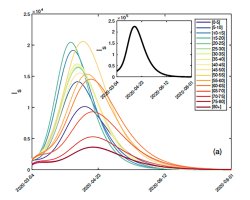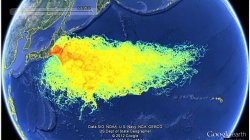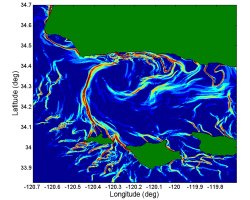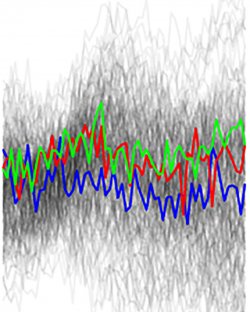Applied Mathematics and Statistics are interdisciplinary fields linking mathematics with many areas of application including:
- biology
- chemistry
- computer science
- engineering
- environmental science
- ecology
- economics
- finance
- physics
- sustainability science
Join us as we solve real-world problems and make an impact in the world.

COVID-19 disease model

Transport of radioactive material
Applied mathematics is focused on developing mathematical methods and applying them to science, engineering, industry, and society. Mathematical topics include partial and ordinary differential equations, linear algebra, numerical analysis, computation, machine learning, operations research, discrete mathematics, optimization, control and probability. Applied mathematics uses mathematical modeling techniques to solve real-world problems.
Statistics is the science concerned with developing and studying methods for collecting, analyzing, interpreting and presenting empirical data. It incorporates Data Analysis but goes beyond to understand uncertainty and variability in the data.
Statistics finds applicability in virtually every field with topics including:
- descriptive statistics
- regression methods
- categorical data analysis
- sampling methods
- computational statistics
- data analysis
- experimental design
- probability models
- multivariate statistics
- non-parametric statistics
- statistical theory
- biostatistics
- data mining
Statistics uses statistical techniques and data analysis to solve real-world problems.
If you care about saving the world, if you care about making this planet a better place, there is not a field that you can go into where you can have a bigger impact …
- How does one predict and contain the spread of infectious disease, utilizing tools such as vaccines and quarantines.
- How does one design a detailed experimental plan for the clinical trial of a new drug.
- How does one quantify the risk/reward of financial assets, bonds, futures, options, etc.
- How does one utilize mathematical and computational models to predict the path of an oil spill.
- How does one estimate the affect of climate related events on society and ecosystems.
- How does one optimize the use of buses and trains for a city’s transit system.
- Is ethanol or other biofuels a viable solution for the world’s dependence on fossil fuels.
- How can automotive and aircraft companies test performance, safety, and ergonomics.
- How do actuaries quantify risk to insurance and pension programs.
- How does one use AI and machine learning to predict energy usage and pollution.
- How can one improve rating prediction performance of e-commerce systems and help enhance the consumer experience.
- How can we provide insight to coastal communities about future sea level rise.
- Companies are hiring more and more applied mathematicians and statisticians every year. The Bureau of Labor Statistics estimates a 33% increase in jobs for individuals with applied mathematics and statistics degrees by 2030.
- The median salary is $101,500.
- Potential industries include:
- Academic and research institutions
- Aerospace companies
- Transportation equipment manufacturers and service providers
- Data analytics organizations
- Forecasting organizations
- Chemical manufacturers
- Pharmaceutical corporations
- Communications services providers
- Computer information and software firms
- Consumer products companies
- Energy systems firms
- Electronics and computer manufacturers
- Engineering firms
- Financial service providers
- Investment management firms
- Banks
- Government labs and agencies (FDA, EPA, DEP, etc.)
- Insurance companies
- Medical device companies
- Consultancy Firms
- Machine Learning and AI firms
- Marketing firms
Curriculum
Navigating the Major
- Take core courses in applied mathematics, statistics, and computing with the Python programming language.
- Choose one application-area sequence with options in biology, chemistry, computer science, earth and environmental science, economics or physics.
- Choose one of three tracks: applied mathematics, mathematics of finance, or statistics.
- Satisfy the experiential learning component: internship or capstone project.

Santa Barbara Channel

Climate Data
These courses provide a broad introduction to theoretical, computational, and statistical techniques.
- Applied Calculus A and Applied Calculus B
- Calculus III
- Introduction to Linear Algebra
- Applied Probability
- Applied Mathematics I
- Mathematical Modelling
- Data Science and Statistics
- Fundamentals of Modern Statistics I
- Python Programming I and Python Programming II
Choose one application-area sequence with options in biology, chemistry, computer science, earth and environmental science, economics or physics.
- Fundamentals of Accounting, Applied Macroeconomics, and Introduction to Finance
- Principles of Biology I and Principles of Biology II
- General Chemistry I and General Chemistry II
- Data Structures and Algorithms in Python, Discrete Mathematics, and Artificial Intelligence
- Data Structures and Algorithms in Python, Introduction to Data Science, and Advanced Techniques in Data Science
- Planet Earth and Understanding Weather and Climate
- University Physics I and University Physics II
- Numerical Computing
- Mathematical Biology I or Dynamics and Bifurcation
- Applied Analysis
- Applied Mathematics II
- Applied Mathematics Research I or Co-Op in Applied Mathematics
- Numerical Computing or Statistical Computing
- Mathematics of Finance I
- Mathematics of Finance II
- Mathematics of Portfolio Theory
- Applied Analysis
- Applied Mathematics Research I or Co-Op in Applied Mathematics
- Statistical Computing
- Fundamentals of Modern Statistics II
- Theory of Statistics
- Introduction to Statistical Data Mining
- Statistical Science Research I or Co-Op in Statistics
- BS Applied Mathematics and Statistics with MS Applied Mathematics
- BS Applied Mathematics and Statistics with MS Statistics
- BS Applied Mathematics and Statistics with MBA
- Four graduate courses are used for both the BS and MS degrees.
- Tuition for these four graduate courses is at the cheaper undergraduate rate. The time to earn both degrees is reduced by 1 year.
More Information
The Department has an excellent group of applied mathematicians, statisticians, and affiliated faculty, all of whom are research active.
- Data-Driven Analysis: Choi, Forgoston, Ivanescu, McDougall, and Su
- Actuarial and Financial Mathematics: Choi and Lal
- Fluid Mechanics: Forgoston, Lorenzo-Trueba, Trubatch, and Vaidya
- Mathematical Biology: Billings, Forgoston, Snitsarev, Song, and Vaidya
- Nonlinear Dynamical Systems: Billings, Choi, Forgoston, Song, and Trubatch
- Scientific Computing: Billings, Eshuis, Forgoston, Lorenzo-Trueba, and Trubatch
- Statistics: Ivanescu, McDougall, and Su
There are many opportunities to do research with a professor. You might even get paid for doing research!
- They are interdisciplinary fields of study and research with links to numerous applications in a wide variety of areas.
- A career in applied mathematics and statistics is more than just crunching numbers. Instead, it involves solving real-world problems and making an impact in the world.
Applied mathematics and statistics allows you to stimulate your curiosity, answering questions in a variety of fields while improving society.
For more information contact Dr. Eric Forgoston eric.forgoston@montclair.edu
If you were excited by what you learned about this program, apply today!
